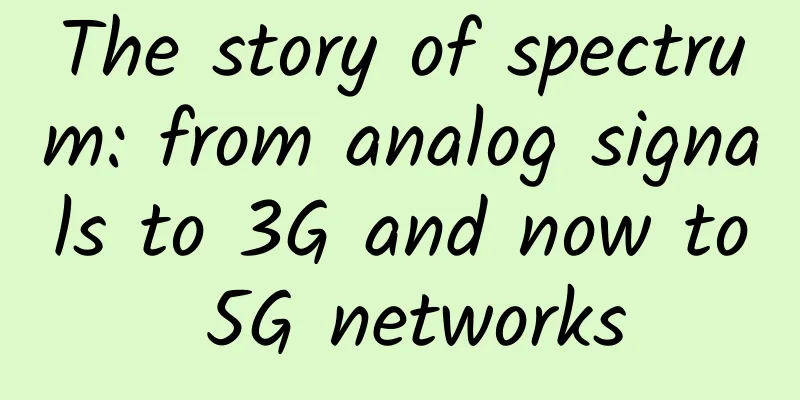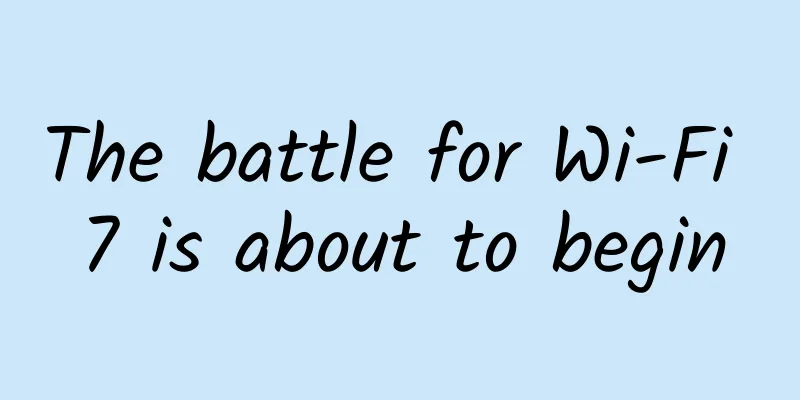The story of spectrum: from analog signals to 3G and now to 5G networks

|
Preface: From telegraph to 5G communication, it is actually a story about spectrum. For more than 100 years, how to use spectrum more efficiently and how to obtain higher transmission rate in limited spectrum have become the goals that many geniuses and corporate giants in the field of wireless communication have been working on. The inventions of telephone, telegraph, television, Internet, mobile phone, etc., which have profoundly changed the development process of human society, accurately reflect the ability of human beings to master and use spectrum. Today, we are going to return to an area that we are more familiar with, and unveil to you the communication transition from analog signals to digital signals in just a few decades, which also records the story of how mankind is moving towards the 5G era. The Age of Analog Communications: The Wonder and Sadness of Talking Anywhere The invention of the telegraph in the 19th century increased the speed of information transmission to 300,000 kilometers per second for the first time. After the fall of the Tower of Babel, peoples from all over the world finally had the possibility to reunite. But no one would have thought that just over 20 years later, Alexander Graham Bell’s first cry for help would become the starting point of the global communication revolution. The wired telephone came into being, and people could have instant conversations even thousands of miles away.
Almost 100 years after the invention of the telephone, in 1986, the world's first commercial mobile communication system was born in Chicago. It used analog signal transmission to convert voice between 300Hz and 3400Hz to a high-frequency carrier frequency of MHz, thereby realizing voice transmission. Thus, mankind officially entered the era of instant voice communication, and taking out a cool mobile phone to make a call anytime and anywhere became a symbol of that era.
However, the disadvantages of analog communication are also very obvious. Since the electrical signal transmitted on the user line changes with the volume of the user's voice, and this changing electrical signal is continuous in time and amplitude, the analog signal has a very low utilization rate of the spectrum and is easily affected by external interference, and often encounters problems of serial number or account theft. More importantly, with the technological level at that time, the antenna technology and analog signal processing technology used in mobile phones directly determined the quality of the product. Under the influence of heavy batteries and long antennas, the ugly brick appearance of mobile phones was not only inconvenient to carry, but the battery life and signal were not optimistic. Users often needed to look for signals in high places.
Although the communication in the analog era required high costs, the wonderful call experience attracted a large number of fans. Don't worry, the GSM era is coming, and it will officially open the 2G era of mobile communications! GSM dominates the world: SMS enters the historical stage! GSM stands for Global System for Mobile Communications. As the second-generation mobile communication technology, its original development purpose was to allow the same mobile phone standard to be used all over the world, and even allow users to use it in any region of the world with just one terminal.
Compared with the first generation of analog signal communication, the digital communication signal of GSM is a discrete, pulsed combination, which is a signal carrying digital information. Therefore, the GSM system has excellent spectrum utilization, and the transmission bandwidth of each channel has also increased. Reflected in practical applications, based on the activation of digital transmission and higher voice coding, the signal strength and call quality in the GSM era have improved by leaps and bounds, and the situation of holding a mobile phone and looking for a signal everywhere is gone forever.
At the same time, higher transmission bandwidth also brought data transmission capabilities to mobile phones for the first time. Although its transmission rate was initially only a pitiful 9.6-14.4Kbit per second, it was enough to meet the needs of text transmission, which is the basis for the realization of SMS function. The 2G era led by the GSM standard also marked the beginning of the battle for global mobile communication standards. After the popularization of GSM, mobile phone products led by Nokia and Ericsson in Europe began to capture the US and Japanese markets. Their prices not only became lower, but also their size was small enough to fit in a pocket. Therefore, less than 10 years later, Nokia became the world's largest mobile phone manufacturer with its Symbian smartphone.
3G ushered in a wireless wave: mobile Internet became possible As users' demand for mobile networks continues to increase, the original slow GSM network is no longer sufficient to support it. Therefore, the establishment of the third-generation mobile communication network standard is imminent, and the well-known WCDMA, CDMA2000 and TD-SCDMA came into being. In fact, there is a well-known story about the birth of 3G network. In 1940, World War II was in full swing in the European battlefield. In order to help the US military create communication technology that could resist the radio interference and eavesdropping of Nazi Germany, American actress Hedy Lamarr and her composer husband first proposed the concept of spread spectrum and frequency hopping technology, and subsequently obtained relevant patents. However, with the end of World War II, Hedy Lamarr's research gradually lost its military significance, but she never thought that these two epoch-making technological achievements would completely change the world half a century later.
In 1985, a little-known American company developed a new communication technology called CMDA based on spread spectrum and frequency hopping technology. In the 2G era, CMDA was suppressed by the GSM standard and became a supporting role, but it indirectly became the basic principle of 3G technology, and the three subsequent 3G standards all benefited from it. And this little-known company at the time is now the famous American Qualcomm.
Whether it is WCDMA, CDMA200 or TD-SCDMA, they all use high-speed digital communications as their selling point. The HSPA+ network evolved from WCDMA even increases the downlink rate to 42Mbps, which means that the era of high-speed mobile networks has officially begun. However, from today's perspective, the HSPA+ network is undoubtedly not enough to satisfy human appetite for high speed, so in the pursuit of faster speeds, humans have taken another big step forward. 4G achieves converged innovation: the era of global roaming is coming The emergence of LTE is enough to put wired connections to shame. The maximum download speed of 100Mbps is 2,000 times faster than dial-up Internet access, and it also makes high-definition video calls and online ultra-clear video playback possible. However, in the 4G era, the changes brought about by mobile communications are more about the realization of global communications. The global full network access proposed as early as the 2G era is finally no longer an empty talk. Whether it is TDD or FDD is no longer important, because we have finally ushered in an era of global roaming. Such achievements are naturally inseparable from the evolution of technical standards and the efforts of technology manufacturers, and Qualcomm has undoubtedly made an indelible contribution. In the 4G era, with Qualcomm Snapdragon mobile platform as the hardware foundation, OEM manufacturers can easily produce smartphones that meet the LTE standards of global operators. For example, the X16 LTE modem built into the latest Qualcomm Snapdragon 835 mobile platform not only achieves full-mode compatibility including LTE-TDD, LTE-FDD, TD-SCDMA, WCDA, GSM, and CDMA, but also covers all frequency bands around the world and provides VoLTE high-definition calling function. At the same time, LTE, as an evolutionary standard in the 4G era, is also eager to lead us to the 5G era. Based on the realization of more carrier aggregation, Qualcomm's X16 LTE modem and the latest X20 LTE modem have now achieved a maximum downlink transmission of 1Gbps (X20 LTE is 1.2Gbps). Among them, the Snapdragon X20 LTE modem can achieve a new frequency band allocation method, mainly because of its flexible use of unlicensed LTE bands - this is a modem that supports the LAA feature (licensed assisted communication). With the existing 5x carrier aggregation support, the X20 LTE modem can allow operators to start Gbps-level LTE services by calling only 10MHz resources, and it has continued to expand the range of supported frequency bands, further improving the flexibility of resource aggregation and allocation. For ordinary users like these, the popularization of 4G has greatly reduced the price of traffic, making watching videos and making video calls on mobile phones commonplace, and has profoundly changed our lives. 5G is already on the way Human beings’ pursuit of speed is endless. The 4G era has just reached the gigabit rate, but the 5G era with a multi-gigabit rate as its goal is already on the way. Qualcomm has taken the lead in announcing 5G NR and has confirmed that it will officially provide the world’s first X50 modem that supports 5G standards to its partners in the second half of 2017. It will use multiple-input multiple-output (MIMO) antenna technology that supports adaptive beamforming and beam tracking technology to achieve stable and continuous mobile broadband communications in non-line-of-sight (NLOS) environments, and can achieve an astonishing downlink rate of up to 5Gbps. At the same time, the characteristics of low latency, high reliability and low power consumption in the 5G era will effectively bring new explosion points to the Internet of Vehicles and the Internet of Things industry, and the Internet of Everything will no longer be an empty talk. Conclusion From the first telephone call made by Bell to the upcoming 5G era, the whole process is like a microcosm of the transition from the industrial era to the Internet era. Since the 2G era, we have ushered in a new wave of speed increases almost every 10 years, which have completely changed our way of life. I believe that in the near future, the 5G era will also become the next turning point of the industry. Let us wait and see! |
>>: Six tips to help you choose the best responsive design framework
Recommend
IDC: Enterprise WLAN market grew strongly in the third quarter
The global consumer and enterprise wireless LAN (...
edgeNAT newly launched VPS in Los Angeles with 40% off monthly payment and 50% off annual payment, US/Hong Kong/Korea data centers
edgeNAT recently opened a new cabinet in the Core...
Build a reliable network and lay the foundation for Wanfeng Aviation Town’s “space dream”!
[[394988]] The 14th Five-Year Plan will accelerat...
Xi'an University of Science and Technology's Smart New Campus 2.0, layout of "IT unified smart operation and maintenance" (Part 1): IT asset full life cycle management
Xi’an University of Architecture and Technology i...
MIIT: 4G and 5G will coexist for a long time, and 5G will not be built to dismantle 4G or limit speed
On August 22, Wen Ku, Director of the Communicati...
The UK invests £1 billion to build a full-fiber network, and 5G and ultra-fast broadband will soon benefit 2 million households
[[177138]] In the near future, 2 million househol...
Fundamentals of Data Center Operations Planning
Enterprises need to develop an effective and adap...
SaltyfishTech: San Jose/Germany CN2 GIA/AS9929 line VPS quarterly payment starts from $19.5
SaltyfishTech, Saltyfish Cloud, is a Chinese host...
Wi-Fi signals are invisible and intangible, but there are actually traces to follow
Labs Guide Have you ever encountered the phenomen...
RAKsmart cluster server 5+253IP monthly payment starts from $189, and you can choose data centers in Los Angeles/San Jose/Japan/Hong Kong, China, etc.
RAKsmart is a foreign hosting company operated by...
Is the backend a bit cumbersome? Go to the client!
Hello everyone, I am Xiaolin. Among Internet posi...
What kind of private network solution does 5G need?
MWC2021 Shanghai has fully demonstrated the achie...
PacificRack July Promotion: Los Angeles KVM monthly payment starts at $1.5, 1G memory package annual payment starts at $12
PacificRack released several special products thi...
What are the main measures and methods to deal with data center downtime?
While data centers are designed to not fail in th...
SDN and IoT drive huge structural changes in networks. IoT is the key to increasing enterprise revenue
According to foreign media reports, the telecommu...









